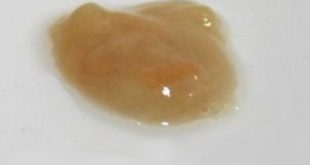Can you get ingrown hair on your scalp? What exactly causes ingrown hairs? Is it normal to get ingrown hair cysts? Here are pictures, symptoms, how to remove and how to get rid of ingrown scalp hair at home.
What is ingrown hair on scalp?
Contents
- What is ingrown hair on scalp?
- What causes ingrown hair on the head?
- Symptoms of ingrown hair
- Ingrown hair cyst on scalp
- Ingrown Hair on Scalp after Haircut
- Ingrown hair on head
- Ingrown hair on the back of head
- Best shampoo for ingrown hair treatment
- Ingrown hair on scalp pictures
- Ingrown hair on head with long hair
- Is it normal hair growing underneath the scalp
- Ingrown Hair on Scalp Removal
- How to get rid of ingrown hair on scalp
- Sources and references
Ingrown hairs on scalp occur as a result of shaving and it may result into small red bumps on the scalp. This condition appears to be abnormal and it mainly occurs in men who shave on a regular basis. It is said to be rare in women unless otherwise.
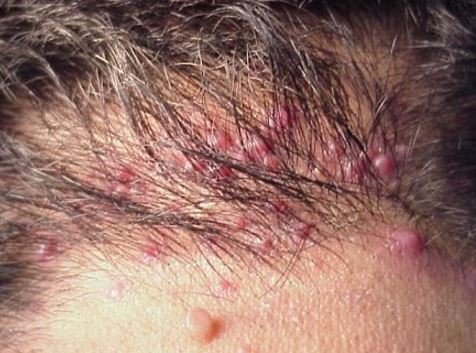
Ingrown hairs on the scalp appear when the hair curls around and grows back into your scalp skin. The twisting and bending of hairs into the skin may result in pimple-like bumps that may be seen around the hairline.
What causes ingrown hair on the head?
The causes include:
1. Poor shaving methods
Inappropriate shaving techniques are the most common cause of ingrown hair on scalp. Also men who keep on shaving their hair on a regular basis are prone to experience this condition.
-
Although everyone is susceptible to get ingrown hair on the head or scalp, it is believed to be common among African American men,
according to Dr. Gary Cole.
Razor bumps can be triggered by regular shaving and it is recommend taking some time until the hair on the scalp grown fully in order curb pimple-like bumps and also ingrown.
2. Clogged hair follicles on the scalp
Clogged hair follicles are known to provide favorable ground for dead skin cells, debris and dirt that will later enhance growth of bacteria that trigger the growth of ingrown hair on the scalp. See also ingrown hair on inner thighs.
When the skin pores are completely blocked with combination of dirt and debris, it causes the hairs to twist back into the skin resulting to ingrown hairs on the scalp.
3. Genetic causes
In case one of your parents or grandparents used to experience hair curling back inside the skin of the scalp resulting in ingrown hairs, then you may not be an exception.
- Ethnicity is also a factor causing ingrown hairs especially those who have African American decent.
- Also men with extremely curly hairs are likely to experience this condition.
4. Excessive use of hair products
Constant use of some hair products on your scalp can also be a factor behind ingrown hairs. Most of these products are known to contain some chemicals that irritate the skin scalp which can later result in bacterial infections on the hair follicles.
- Constant irritation of the skin scalp may cause the appearance of ingrown hair bumps either in clusters. These may appear along the hairline or random big bumps on the head.
5. Health condition
The underlying health condition of your scalp matters a lot as far as ingrown hair is concern. If you happen to have a weak immune system and then avoid any cuts when shaving since it may results in an infected ingrown hairs.
6. Naturally curly and coarse hairs
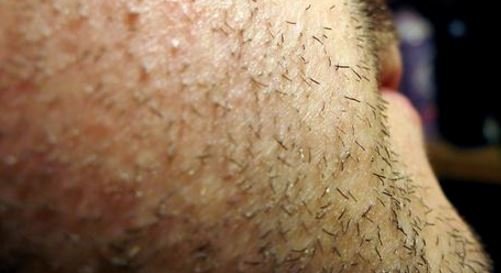
Individuals with naturally curly and coarse hair are more susceptible of getting ingrown hairs those tight curly hairs mostly bend inside the skin of scalp resulting into ingrown hairs. This condition is more common to those individuals who are of African American or Asian descent.
7. Frequent use of hats and head covers
Individuals with naturally curly and coarse hair are more susceptible to getting ingrown hairs. Those tight curly hairs mostly bend inside the skin of scalp resulting into ingrown hairs. Other lesser causes of ingrown hairs include:
- Tweezing and waxing
- Dry scalp skin
- Bacterial and fungal infection
- Friction due to itching effect
Symptoms of ingrown hair
A scalp that has ingrown hairs is marked by the following signs and symptoms:
- Red bumps
- Itchy scalp
- Scalp skin irritation
- Pus filled bumps
- Aggravated scalp skin- scalp inflammation
Ingrown hair cyst on scalp
Apart from having the capability of appearing on any part of the body, ingrown hair follicle cysts can occur on the scalp mostly due to shaving especially among men who do regular shaving on the head.
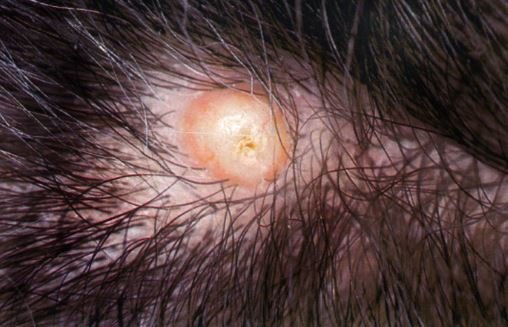
It is advisable to get rid of them as soon as possible since they tend to be very painful once they are infected. When they get a bacterial infection, they can lead to a more serious complication.
Here are some of the common causes of ingrown hair on scalp that can help to distinguish them from normal cysts. They include:
Shaving
During this process, one may experience razor bumps and razor burns that tend to irritate the scalp skin causing the cut hair to bend inside the skin and grow which in turn will result in ingrown hair on scalp that is infected.
Waxing
In case you happen to go for waxing and it is done in appropriate way, it tempers with the direction of hair growth thus resulting in ingrown hair cysts.
High amount of sex hormones
Once an individual has high level of sex hormones in the body, it may trigger increase in growth of hair. Ingrown hair on the head will start appearing since the excess hair will lack space for growth so they will keep on bending inside the skin scalp.
Clogged pores
It is considered to be the main causes of ingrown hair cysts since pores reduce the space for hair growth. Clogging of hair pores occurs due to accumulation of dirt, excess oil and dead skin cells.
Cystic acne
In case you notice the presence of bumps on the skin scalp, it could be due to blocked hair pores that result due accumulation of dirt and dead skin cells. This condition reduces the chances of hair growth in a proper direction but in turn make the hairs to twist and bend inside the skin scalp resulting into scalp acne.
Naturally curly hair
People with curly hair have high probability of getting ingrown hair cyst. It happens since their hair is naturally associated with bending backwards into the scalp skin leading into ingrown hair cyst.
Scalp skin diseases
There are some scalp skin diseases known for causing ingrown hair cyst on head since they have the capability of making the skin to appear thick making it difficult for the hairs to grow outwards easily. Since the hair lacks proper direction of growth, it results in ingrown hair on the head.
This condition is characterized by the following symptoms of ingrown hair cysts
Irritation of scalp skin
This condition resulted due to the body response to enhance healing process by releasing certain chemicals but in turn causes irritation on the scalp skin.
Scalp inflammation
It also happens due to the response of the body toward the cysts which is seen as an intruder. The cyst is then attacked by enzymes responsible causing vasodilation of blood vessels that later leads to inflammation on the skin due to accumulation of fluids on the skin surface.
Discharge of pus
A bacteria can invade the ingrown hair cyst which can later leads to a discharge of either yellow or green in a more consistency way.
Redness around the scalp skin
In most occasions, redness around the ingrown hair cysts is usually due to skin irritation that occurs as a result of vasodilation of blood vessels on the surface of scalp skin.
Pain and tenderness
It is a common symptom that occurs due to excessive itching of the scalp due to inflammation. Also, pain appears when there is a damage done on the epithelium lining and the pain can either range from mild or sever state.
Ingrown Hair on Scalp after Haircut
Ingrown hairs are known to be cause by various factors, but the most common one is hair removal techniques from your scalp. The most common methods are waxing, shaving or tweezing and for sure this can lead to ingrown hair on scalp.
Using a wrong technique in shaving, then you are likely to develop ingrown hairs. Also, if you take inappropriate precautions while shaving, there is a possibility of development small bumps on your scalp especially along the hairline and for sure they will be painful.
Ingrown hair on head
As mentioned earlier, ingrown hairs are those hairs that grow back into the scalp skin. Although the condition can be painful, it should raise any alarm. Ingrown hairs are common in women around the armpits, and on the head.
Since most women like to observe high personal hygiene, they may end up shaving their hairs especially in the armpits and pubic area more frequently and this may sharpen the edges of the hair follicles. This enhances the hair to grow backwards easily resulting into ingrown hairs.
Again, these ingrown hairs can block new hairs from growing in a proper direction by trapping them inside. Also, your hair on scalp can become ingrown by themselves.
Ingrown hair on the back of head
Ingrown hair on scalp is known to happen in the following ways:
Extra follicular
This is a condition that happens to those individual with curly hairs that bend and reenters the scalp skin leading to the formation of ingrown hairs especially at the back of your head.
Tran follicular
This is another condition that is common especially among those individuals who cut their hairs on a regular basis. The sharp edges of growing hair follicle will penetrate the scalp skin resulting in ingrown hair on scalp.
According to WebMD, ingrown hair on scalp will generate the development of raised bumps that looks like small pimple and they can be inform of painful boil-like sores when you touch.
Best shampoo for ingrown hair treatment
If you happen to have a very sensitive skin on the scalp, then you should as much as possible to avoid things that could irritate it such those hair products that contain harsh chemicals since they can trigger an allergic reaction.
Mild shampoos and some other hair care products can be obtained through the counter. Since everyone has different hair texture and growth style, I do recommend you visit a professional hair care shops or a dermatologist who will be able to identify the best shampoo that can fit the features of your hair.
Ingrown hair on scalp pictures
Most of the pictures in the article try show where these ingrown hairs are located ranging from behind the head up to the temple of the head.
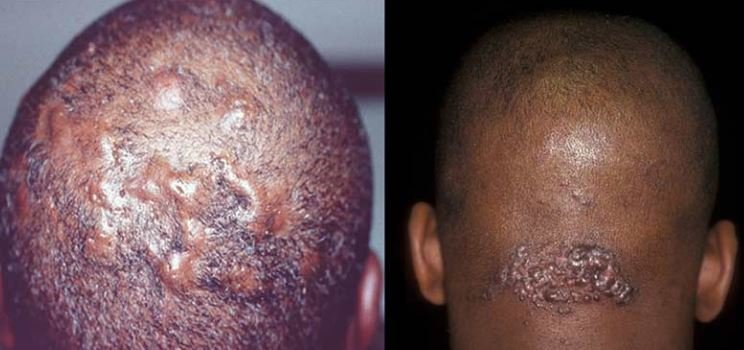
The pictures brings out vividly how the ingrown hair can result in to tiny pimples around the upper neck, all over the head, and mostly on the hairlines.
Have a look on the pictures and try to figure out if you are experiencing one of the symptoms before seeking proper precautions to treat the ingrowing follicles.
Ingrown hair on head with long hair
Sometimes it is possible for an individual to have ingrown hair on scalp with long hair especially those individuals who happen to have high level of sex hormones.
These hormones can result into excessive hair growth that can contribute to lack of enough space for growth in a proper direction resulting into ingrown hairs. In women it could be due to polycystic ovary syndrome and it is advisable to visit a specialist to detect this hormonal abnormalities.
Is it normal hair growing underneath the scalp
It is not normal for hair to grow underneath the scalp unless it is ingrown hairs. In case you experience some sort of pain that is not ending, I recommend you visit a specialist to detect the underlying problem.
Most of the pain experienced is usually inform of inflammation and itching. Also, you may be susceptible of getting ingrown cysts and boils on the scalp.
Note: visit your medical care for proper treatment and maintain high level of personal hygiene on the scalp.
Ingrown Hair on Scalp Removal
Removal of ingrown hair on scalp is all about determination and self-discipline. It involves the following stages:
- Step 1: It is recommended to grow out your hair and if you wish to maintain it short then use clippers from barber to trim off hair to the require height so as to avoid cases of ingrown hairs.
- Step 2: Keep away from wearing hats or covering your head with any other form of scalp clothing materials since accumulation of sweat and constant friction may cause ingrown hair bump and it would further inhibit ingrown hair that is infected from healing.
- Step 3: It is recommended to shampoo your hair occasional in order to get rid of dead skin cells by rubbing your head with toothbrush or rough washcloth and try to remove ingrown hair on scalp skin.
- Step 4: Use a hot compress pack on your scalp for about 15minutes daily. It helps to open up the skin pores and also drain out the bumps.
- Step 5: Utilize hydrocortisone cream to the bumps to reduce inflammation caused by ingrown hair cyst and help in controlling itching.
- Step 6: Try to avoid scratching ingrown hair on your scalp since it may result into hyperpigmentation and formation of scars as you try dig out a deep embedded ingrown hair on head.
How to get rid of ingrown hair on scalp
Natural remedies on ingrown hair on head include:
1. Black Tea Bags
It is characterized by having tannic acid, which reduces redness and inflammation and helps soothe the skin. Here are some steps:
- Moisten a black tea bag in warm water.
- Rub it over the affected area for two to three minutes.
- Repeat several times daily as needed.
2. Aspirin paste
It is known to have anti-inflammatory property thus helps in reducing inflammation and heal mild ingrown hair infections.
- Moisten two aspirin tablets in warm water until there is formation of paste.
- Add one teaspoon of honey to the paste.
- Apply the paste to the affected area.
- Leave it on for 10 minutes. Wash it off with warm water and then gently pat the skin dry.
3. Apply honey
It is a natural remedy that contains antibacterial properties and also helps to moisturize the affected area as well as reduce inflammation around the ingrown hairs.
It is applied using the following ways:
- Utilize a layer of honey directly on the irritated scalp skin.
- Let it dry for about 3 minutes. Then rinse it off with cold water.
4. Apply aloe Vera gel
It is one of the natural remedy that has been used for treating razor bumps and razor burns. It has a soothing effect; therefore it provides relief on itching and inflammation instantly.
It also keeps the scalp skin moisturized and enhances healing of ingrown hairs that are infected. Here are tips to follow when using aloe Vera.
- Obtain the gel from a fresh aloe vera .
- Apply the gel on the scalp skin that is irritated by rubbing
- Wash the scalp after 5minutes with luke-warm water
5. Apple Cider Vinegar
Due to its ability to reduce inflammation and irritation, it also helps to get rid of an infected ingrown hair on scalp by destroying the bacteria causing agent.
- Apply the vinegar on the affected area
- Give it air dry for about 10 minutes and then wash with lukewarm water.
- Follow the steps until all the ingrown hairs are treated.
Sources and references
- How to deal with an ingrown hair cyst:
- Things That Will Always Cause Ingrown Hairs, Torture Our Souls:
- Ingrown Head Hairs: http://www.ehow.com/about_6610119_ingrown-head-hairs.html
- How to Remove an Ingrown Hair Quickly, Easily, and Without Any Lasers Whatsoever: https://www.bustle.com/articles/57123-how-to-remove-an-ingrown-hair-quickly-easily-and-without-any-lasers-whatsoever
- Ingrown Hair on Head Scalp Pictures, Symptoms, Removal & Treatment:
